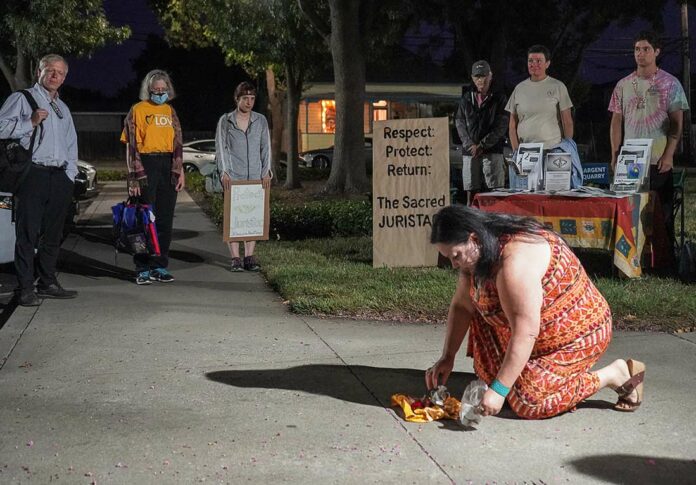
The Gilroy City Council voted unanimously Aug. 15 to voice its opposition to the proposed quarry just south of the city, but noted that while such a resolution makes a strong statement, the county is ultimately in charge of the project’s fate.
A formal resolution is expected to be considered by the council in September, which would then be sent to county officials as part of their deliberations on the Sargent Ranch Quarry Project. The council, however, narrowly declined to direct a city staff member to publicly comment on the project at the upcoming Aug. 25 county planning commission meeting, on the advice of City Administrator Jimmy Forbis, who said it would put a staff member in an usual position of criticizing a project outside of their jurisdiction.
In late July, county planners released the draft Environmental Impact Report for the 403-acre quarry project, proposed about four miles south of Gilroy near the Highway 101/25 interchange.
The open-pit sand gravel mining operation is proposed by Sargent Ranch Partners, LLC. The proposal consists of a 298-acre mining site and a 105-acre “geotechnical setback area” to serve as a buffer from surrounding uses, according to the draft EIR.
The property is within the largely undeveloped Sargent Ranch, which occupies about 6,200 acres in Santa Clara, San Benito and Santa Cruz counties.
San Diego-based Debt Acquisition Company of America purchased the majority of the Sargent Ranch land in 2013 after previous owner Pierce’s Sargent Ranch LLC filed for bankruptcy. Freeman Associates LLC of Palo Alto, which represents Sargent Ranch Management Company, submitted the mining application in 2015 on behalf of the more than 100 owners of Sargent Ranch lands.
The applicant is requesting a 30-year mining permit from Santa Clara County, according to the draft EIR. The proposed mining operations would be conducted in four phases.
The project is meant to provide sand and gravel aggregate for contractors and public agencies. The site is estimated to contain 40 million tons of sand and gravel aggregate. Extracted material would be transported off site by trucks and trains, according to the draft EIR.
The environmental report found that the project would create “significant and unavoidable impacts” in six categories: aesthetics; air quality; biological resources; cultural and tribal cultural resources; geology, soils and paleontology; and transportation.
Members of the Amah Mutsun Tribe have opposed the Sargent Mine proposal for years because it sits on untouched land within Juristac, the tribe’s sacred ancestral home. The land was home to Mutsun ancestors who performed ceremonies there for thousands of years, according to tribe members.
Valentin Lopez, chairman of the Amah Mutsun Tribal Band, said the history of the tribe has been “ignored, forgotten and erased” through time, and the quarry project on Juristac would “forever desecrate this sacred place.”
“What we want to do is turn Juristac into a tribal village, and then we would like to find a location for a cultural center and a museum for the Amah Mutsun people,” he said. “We would love for that to be in Gilroy.”
During the council’s meeting, 12 people spoke, all in opposition to the project, citing concerns over habitat removal, added traffic and cultural impacts on the Amah Mutsun.
Retired science teacher Michelle Nelson said she was “dubious” about the project’s claims to “reclaim the land” after the quarry closes in three decades.
“If the animals are gone, they’re gone,” she said. “Thirty years is irreversible in my opinion.”
Sally Armendariz of Gilroy, citing her Indigenous roots, said the native peoples have very little land and culture left in the region.
“We, Gilroy Strong, should do all we can to protect and restore [Juristac] to its righteous owners,” she said.
While the council was all in opposition to the quarry project, with Councilmember Dion Bracco saying the land is “some of the most beautiful, pristine places you can see,” it was split on directing a city staff member to speak at an upcoming public meeting.
Councilmember Fred Tovar made a motion to oppose the project, and accepted Councilmember Rebeca Armendariz’s amendment to direct staff to speak.
“It seems so passive to have a resolution versus actually having staff saying, ‘Hey, this is our community, look at how heavily it’s going to impact us in terms of traffic, the environment and culture,’” Armendariz said.
Forbis recommended against the idea.
“We would essentially be doing a peer review of an EIR that has already identified the negative consequences of a project like this,” he said. “It puts staff in an unusual position of criticizing our peers on a project that’s not in our jurisdiction.”
The amendment failed, with Mayor Marie Blankley and Councilmembers Bracco, Peter Leroe-Munoz and Carol Marques dissenting.
A motion by Tovar to oppose the project without the commenting amendment then passed unanimously.
Santa Clara County officials will host a virtual public meeting at 1:30pm Aug. 25 to receive comments on the draft EIR. The meeting will take place before the county planning commission.
Written comments can be submitted by email to Santa Clara County Senior Planner Robert Salisbury at sg****************@********ov.org. Comments must be submitted by 5pm Sept. 26.
To view the draft EIR, visit bit.ly/3oyQNQZ.
After the public comment period for the draft document, the county and applicant will compile a Final EIR, which will ultimately require approval by the Santa Clara County Board of Supervisors before the mine can gain a permit.
Michael Moore contributed to this report.












